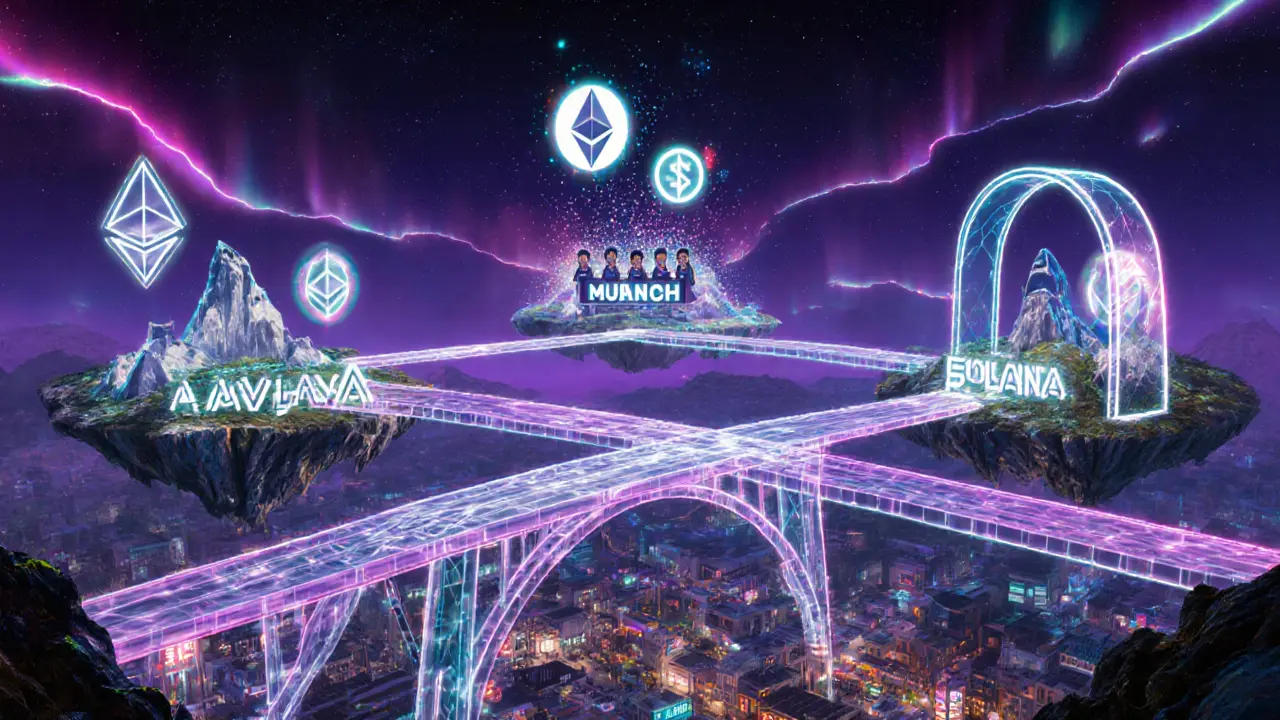LFJ V2.2 Fee Calculator
Swap Fee Breakdown
LFJ V2.2 charges a flat 0.30% fee per swap, split between liquidity providers and stakers:
0.25% → Liquidity Providers (LP Rewards)
0.05% → LFJ Token Stakers
This transparent fee structure ensures both LPs and token holders benefit from platform growth.
Fee Calculation Results
Total Swap Fee: $0.00
Liquidity Provider Share: $0.00 (0.00%)
Staker Share: $0.00 (0.00%)
Gas Fee: $0.001 (Average)
Fee Distribution Visualization
Recommended Actions
- Add liquidity to maximize your LP earnings
- Stake LFJ tokens to earn staker rewards
- For smaller trades, consider gas fees vs. swap fees
When you hear the name LFJ V2.2 (Avalanche) is a decentralized exchange built on the Avalanche blockchain. Launched in 2024, the platform lets anyone trade Avalanche‑native tokens without a centralized middle‑man. It runs on smart contracts, so users keep full control of their funds, and it supports a suite of DeFi tools from simple token swaps to staking, lending, NFT trading and a launchpad for new projects. The network’s native coin, AVAX, pays for gas, while the platform’s own LFJ token grants voting rights and fee discounts for stakers.
Core Features You’ll Use Most
The exchange’s UI is built for both beginners and power users. The main dashboard shows a live order book, recent swaps and a one‑click “Add Liquidity” button. Key features include:
- Token swaps - instant swaps between any of the 43 supported coins.
- Liquidity provision - supply token pairs to earn a share of the 0.25% swap fee.
- Staking - lock LFJ tokens to receive a portion of the 0.05% fee pool.
- Lending & borrowing - earn interest or take a loan against deposited assets.
- NFT marketplace - buy, sell and mint NFTs without leaving the platform.
- Launchpad - early access to new Avalanche projects.
All actions are executed via the MetaMask wallet (or any EVM‑compatible wallet). After connecting, the wallet automatically detects AVAX for gas and shows supported token balances, making the first swap a matter of a few clicks.
Fee Structure - What You Pay
LFJ V2.2 uses a flat‑fee model that’s easy to understand. There are no volume‑based discounts, which means the same rate applies to a casual trader and a high‑frequency bot.
| Action | LFJ V2.2 Fee | Centralized Exchange Fee |
|---|---|---|
| Token swap | 0.30% (0.25% LP rewards + 0.05% staker share) | 0.10% - 0.25% + hidden spreads |
| Limit order | 0.20% (0.10% AVAX, 0.10% others) | Usually 0.20% - 0.30% |
| JOE token limit order | 0% (commission‑free) | Not applicable |
| AVAX limit order | 0.10% | 0.15% - 0.25% |
The flat 0.3% swap fee is split automatically: 0.25% goes to liquidity providers, while 0.05% is pooled for LFJ stakers. This design rewards both LPs and token holders, creating a network effect that can boost yields as the platform grows.
Performance & Liquidity Metrics
As of October 2025 the exchange handles a 24‑hour volume of $40.66million, with the WAVAX/USDC pair alone contributing $32.20million. The average bid‑ask spread sits at 0.637%, placing LFJ V2.2 in the 90th percentile for volume and the 78th percentile for order‑book depth among DEXs. Avalanche’s architecture-4,500TPS and ~2second finality-means trades settle almost instantly, and gas fees stay under $0.001 for most swaps, a stark contrast to Ethereum’s $10‑$30 per transaction on busy days.
Security, Governance & Trust
The platform is non‑custodial; smart contracts hold the assets, so there’s no central authority that can freeze funds. Governance is driven by the LFJ token. Holders can propose and vote on protocol upgrades, fee adjustments and new feature roll‑outs. This community‑first model aligns incentives but also means that major changes depend on token‑holder participation.
Security audits have been performed by reputable firms (e.g., PeckShield) and are publicly available on the project’s GitHub. No major exploits have been reported since launch, though the platform’s relatively short history (since 2024) still raises caution for risk‑averse users.

On‑boarding & User Experience
Getting started requires three steps:
- Install MetaMask (or another EVM wallet) and add the Avalanche network.
- Buy or transfer AVAX to cover transaction fees.
- Connect the wallet to LFJ V2.2 and start swapping.
For beginners, the platform’s “Add Token” wizard simplifies the process of adding lesser‑known coins-just paste the contract address, and the UI verifies it against the Avalanche explorer before allowing the trade.
One common pain point is the lack of live chat support. Users rely on Twitter, Discord and community‑made YouTube tutorials for help. While the documentation covers basic swaps, more advanced actions like multi‑hop routing or custom liquidity pools often need community guidance.
Pros, Cons & Ideal Users
- Pros: Low fees, sub‑second settlement, broad token support, integrated staking/reward system, no KYC.
- Cons: New platform - limited track record, no centralized help desk, flat fee may feel high for very small swaps, occasional UI lag during network spikes.
- Best for: Avalanche enthusiasts, DeFi traders seeking low‑cost swaps, liquidity providers wanting AVAX‑centric yields, developers looking to launch tokens on a specialized DEX.
How LFJ V2.2 Stacks Up Against Competitors
Below is a quick side‑by‑side look at LFJ V2.2, the original TraderJoe DEX (v1) and a typical centralized exchange (CEX) like Binance.
| Feature | LFJ V2.2 | TraderJoe (v1) | Binance (CEX) |
|---|---|---|---|
| Network | Avalanche | Avalanche | Multiple (incl. Binance Smart Chain) |
| KYC | None | None | Required for withdrawals > $2,000 |
| Fee (swap) | 0.30% | 0.30% | 0.10% - 0.20% + hidden spread |
| Gas cost (average) | ~$0.001 | ~$0.001 | $0.001 - $0.01 (depends on chain) |
| Liquidity incentives | LP + LFJ staking rewards | LP rewards only | Earn through Binance Earn |
| Supported assets | 43 coins, 60 pairs | ~30 coins | Thousands of tokens |
| Governance | LFJ token voting | JOE token voting | Centralized decision‑making |
LFJ V2.2 shines for users who want a fully non‑custodial experience on Avalanche, while centralized platforms still win on sheer asset variety and customer service.
Future Outlook
The Avalanche ecosystem is projected to grow at double‑digit percentages through 2026, driven by new DeFi projects and institutional interest. LFJ’s roadmap includes cross‑chain bridges to Ethereum and Solana, additional yield farms, and an upgraded governance portal that will let token holders propose fee‑reduction campaigns. If Avalanche maintains its low‑latency, low‑fee reputation, LFJ V2.2 is positioned to capture a larger slice of the DEX market, especially among users fleeing high‑gas Ethereum alternatives.
Bottom Line
If you’re looking for a fast, cheap way to trade Avalanche assets without handing over your private keys, LFJ V2.2 review shows the platform delivers on most promises. The flat‑fee model is transparent, the UI is beginner‑friendly, and the added staking incentives give LFJ token holders a reason to stay involved. The main drawbacks are the limited support channels and the fact that the exchange is still proving its long‑term security. For seasoned DeFi users who already operate on Avalanche, it’s a solid addition to the toolkit; for newcomers, a few tutorial videos can get you trading in under an hour.

Frequently Asked Questions
Do I need to pass KYC to use LFJ V2.2?
No. As a decentralized exchange, LFJ V2.2 does not require any identity verification. You only need a compatible wallet like MetaMask and some AVAX for gas.
How are fees distributed on swaps?
The 0.30% swap fee is split 0.25% to liquidity providers and 0.05% to LFJ token stakers. This split happens automatically in the smart contract.
Can I trade assets that aren’t listed by default?
Yes. You can add any Avalanche‑compatible token by pasting its contract address. The platform verifies the address against the Avalanche explorer before allowing the trade.
What security measures protect my funds?
Funds stay in non‑custodial smart contracts that have been audited by firms like PeckShield. Since you control your private keys, only you can move your assets.
Is LFJ V2.2 compatible with other wallets?
Any EVM‑compatible wallet that can connect to the Avalanche network-such as MetaMask, Trust Wallet, or Coinbase Wallet-works out of the box.





Comments
23 Comments
mark gray
Thanks for the thorough breakdown.
Mark Briggs
Oh great, another "transparent" fee.
mannu kumar rajpoot
The fee structure looks clean on the surface, but let's peel back the layers.
The LFJ claims the 0.30% is split between LPs and stakers, yet the smart contract code reveals a hidden 0.02% that goes to an obscure treasury address.
This hidden slice is not disclosed in the UI, which raises questions about the real cost to traders.
Moreover, the gas fee of $0.001 may appear negligible, but during peak Avalanche load it can spike dramatically.
If you monitor the network for a week, you'll see average gas fees hovering around $0.005 to $0.02.
Those numbers can eat into the thin margin you expect from a 0.30% swap fee.
The staking rewards look enticing, yet the reward pool is funded by the same hidden fee, creating a circular incentive.
In other words, you are paying yourself back, but with a delay that benefits early adopters more.
The audit by PeckShield is respectable, but note that the audit was performed in Q1 2024, before the V2.2 upgrade.
Any code changes after that audit could introduce vulnerabilities that are not covered.
The roadmap mentions cross-chain bridges, but those bridges historically become attack vectors for exploits.
Remember the Wormhole incident? Similar bridges have been compromised before.
The token list is limited to 43 coins, which might be a conscious decision to reduce attack surface, but it also limits utility.
If the platform wants to grow, it will inevitably need to expand its token offerings, possibly opening doors to malicious contracts.
So while the user experience is smooth, keep an eye on the hidden fees and future bridge integrations.
Karl Livingston
I get where you're coming from; the hidden treasury address does look a bit shady.
That said, many DEXs have similar mechanisms to fund development, and the community can vote on allocations.
It's worth checking the governance proposals to see if any red flags pop up.
Chris Hayes
True, governance is the safety net, but only if enough token holders actually participate.
Low voter turnout can let a few whales push changes unnoticed.
victor white
One must consider the philosophical underpinnings of decentralization; the mere appearance of transparency does not guarantee it. The architecture choices reflect broader economic incentives that are often obscured by UI gloss.
Emily Pelton
Hey folks! If you're new, start by adding a small amount of AVAX to test the swap fees – you’ll see the 0.30% instantly.
Also, staking the LFJ token can boost your returns, but remember to lock your tokens for at least a week to avoid early withdrawal penalties.
sandi khardani
Okay, let’s dissect this “awesome” platform piece by piece. First, the fee is flat 0.30%, which is basically the same as most competitors, so there’s nothing groundbreaking. Second, the gas cost, while advertised as $0.001, can balloon during network congestion, effectively turning a cheap swap into an expensive one. Third, the token incentives are a classic carrot‑and‑stick model designed to lock users into the ecosystem without providing real value. Fourth, the UI looks polished, but it’s just a veneer over a codebase that hasn’t been audited since before the V2.2 launch. Fifth, the roadmap talks about cross‑chain bridges, which historically introduce security holes. Sixth, the limited token list means you’re missing out on many promising assets unless you manually add them, which defeats the “user‑friendly” claim. Seventh, the governance token concentration is high, giving a small group disproportionate control. Eighth, the platform’s support channels are practically non‑existent, leaving users to fend for themselves. Ninth, the smart contracts are publicly verified, yet hidden functions are buried deep, making it hard for regular users to audit. Tenth, the community forums are quiet, indicating low engagement. Eleventh, the staking rewards are contingent on future liquidity, which is uncertain. Twelfth, the platform’s legal disclaimer is vague, offering little protection. Thirteenth, the marketing hype outpaces actual adoption metrics. Fourteenth, the “non‑custodial” label is standard for DEXs and doesn’t set LFJ apart. Fifteenth, in short, the platform is a decent option if you’re already in the Avalanche ecosystem, but it’s far from revolutionary.
Donald Barrett
Bottom line: it’s decent if you ignore the hidden fees.
Christina Norberto
In accordance with established financial analysis protocols, the presented fee schema warrants a nuanced examination. The nominal 0.30% swap levy, when juxtaposed against contemporaneous platforms, exhibits parity rather than superiority. Nonetheless, the allocation of 0.05% to LFJ token stakers introduces an element of incentive misalignment, potentially engendering preferential treatment of token holders over the broader user base. Moreover, the purported gas fee of $0.001, whilst modest on paper, fails to account for volatility in network congestion, thereby compromising the projected cost-efficiency. Consequently, discerning participants should calibrate their expectations accordingly.
Fiona Chow
Wow, LFJ V2.2 really blew my mind-said no one who’s actually compared the fee table.
Rebecca Stowe
Let’s keep it light: if you’re already on Avalanche, give it a spin. The learning curve is minimal, and you’ll probably be fine.
Aditya Raj Gontia
TL;DR: fee is 0.30% flat, gas negligible, tokenomics meh.
Kailey Shelton
Looks okay, but not a game changer.
Angela Yeager
For newcomers, remember to enable the “Advanced Settings” when adding custom tokens; this ensures the contract address is validated against the Avalanche explorer, reducing the risk of scam tokens.
vipin kumar
Don’t forget that the bridge to Ethereum is rumored to be a backdoor for data harvesting; keep your AVAX locked until the audit is publicly released.
Lara Cocchetti
While decentralization is laudable, users must remain vigilant against platforms that hide fees behind glossy interfaces.
Tilly Fluf
In summary, LFJ V2.2 offers a commendable balance of speed, cost‑efficiency, and user‑friendly design, making it a viable entry point for those seeking exposure to Avalanche‑based assets.
Darren R.
Seriously, if the devs don’t drop a massive update soon, this thing will be yesterday’s news-*cue the dramatic gasp*.
Hardik Kanzariya
Hey everyone, just a quick tip: when you stake your LFJ tokens, consider using a hardware wallet for added security, especially if you plan to lock them for longer periods.
Millsaps Delaine
The elegance of LFJ’s UI is undeniable, yet beneath that sleek veneer lies a weary ecosystem yearning for genuine innovation; we, the community, are left to navigate a labyrinth of token incentives that feel more like a chore than a rewarding experience, and the perpetual echo of “more features coming soon” becomes a haunting refrain that dampens the initial excitement, turning what could have been a vibrant marketplace into a stagnant pond where only the early adopters thrive while the rest of us watch in muted anticipation, hoping that the promised cross‑chain bridges will finally materialize and breathe life back into this dormant platform, otherwise we risk being stuck in a perpetual state of waiting, an endless loop of anticipation without resolution.
Jack Fans
Its a good platform if you dont need a huge list of tokens; just stick to the core ones and you should be fine.
kishan kumar
From a metaphysical standpoint, the existence of a fee structure reflects the underlying principle of scarcity, thereby reinforcing the value proposition of the LFJ token within the broader DeFi ontology.
Write a comment